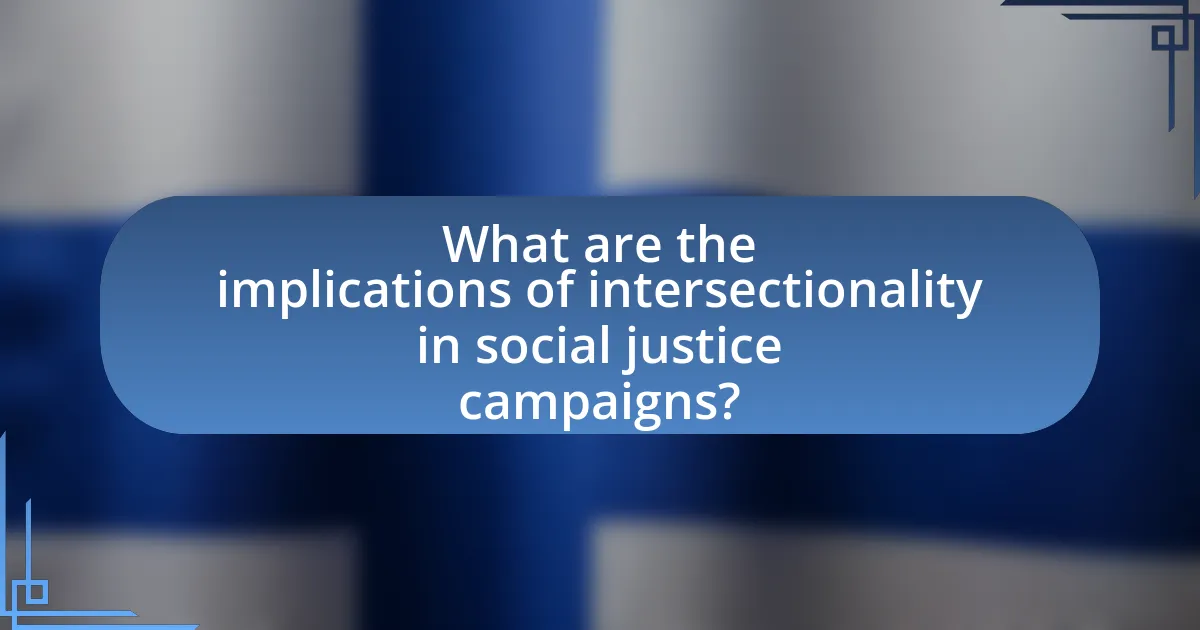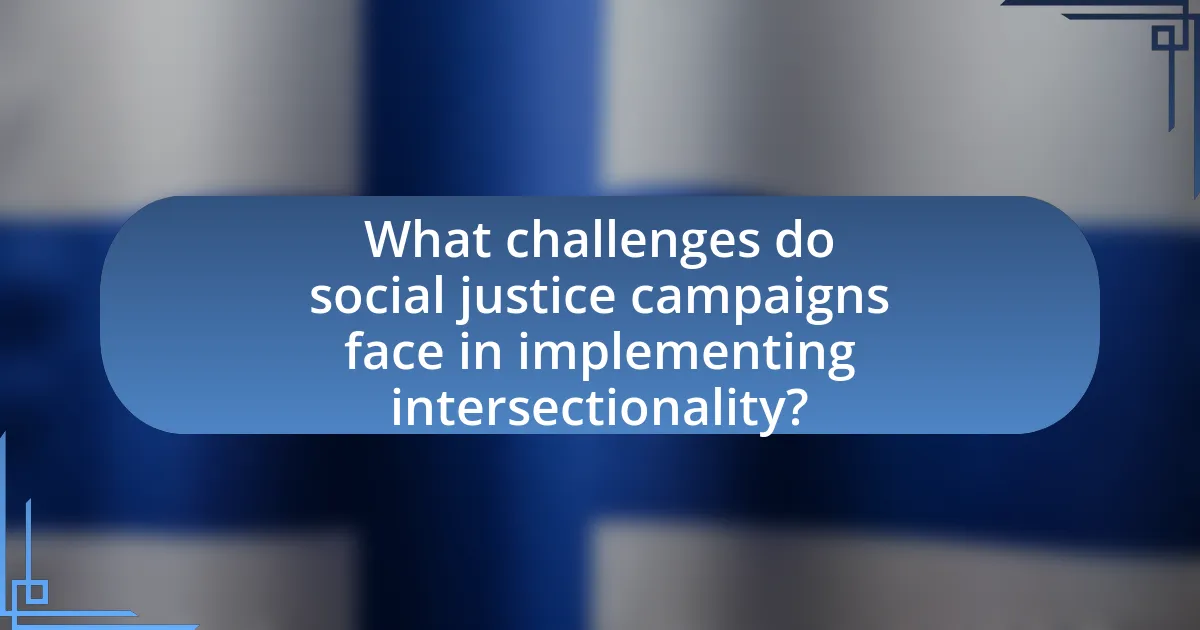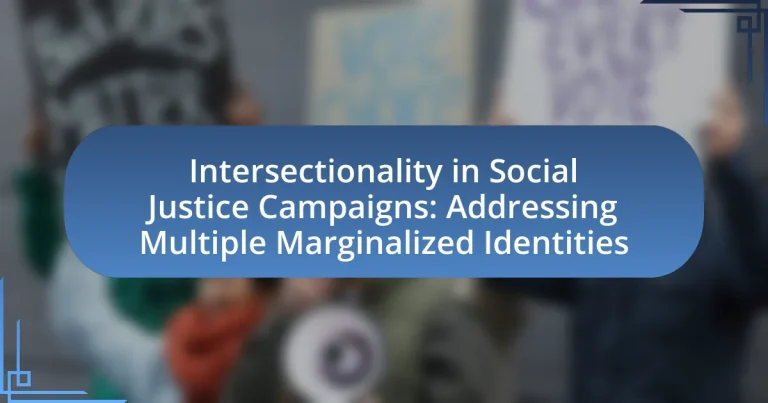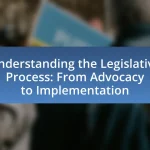Intersectionality in social justice campaigns is a framework that examines how overlapping social identities—such as race, gender, sexuality, and class—interact to create unique experiences of oppression and privilege. This concept, introduced by Kimberlé Crenshaw, emphasizes the necessity of addressing multiple marginalized identities to develop effective advocacy strategies. The article explores how intersectionality influences social justice movements, the key principles underlying this approach, and the challenges faced by individuals with intersecting identities. It also discusses the importance of inclusive representation, community engagement, and targeted strategies in enhancing the effectiveness of social justice campaigns, ultimately advocating for a more comprehensive understanding of systemic inequality.

What is Intersectionality in Social Justice Campaigns?
Intersectionality in social justice campaigns refers to the framework that examines how various social identities, such as race, gender, sexuality, and class, intersect to create unique experiences of oppression and privilege. This concept, introduced by Kimberlé Crenshaw in 1989, highlights that individuals do not experience discrimination in isolation; rather, their multiple identities can compound their experiences of marginalization. For instance, a Black woman may face both racial and gender discrimination simultaneously, which cannot be fully understood by analyzing race or gender separately. This understanding is crucial for developing effective social justice strategies that address the complexities of systemic inequality and advocate for the rights of all marginalized groups.
How does intersectionality influence social justice movements?
Intersectionality significantly influences social justice movements by highlighting the interconnected nature of social categorizations such as race, gender, and class, which create overlapping systems of discrimination or disadvantage. This framework allows activists to understand that individuals experience oppression in varied and complex ways, necessitating a more inclusive approach to advocacy. For instance, the Black Lives Matter movement incorporates intersectional perspectives by addressing not only police violence against Black individuals but also the unique challenges faced by Black women and LGBTQ+ individuals within that context. Research by Kimberlé Crenshaw, who coined the term “intersectionality,” emphasizes that failing to consider these intersecting identities can lead to inadequate solutions that do not fully address the needs of all marginalized groups. Thus, intersectionality enriches social justice movements by ensuring that diverse voices and experiences are recognized and addressed in the fight for equity.
What are the key principles of intersectionality?
The key principles of intersectionality include the recognition that individuals experience overlapping social identities, which can lead to unique forms of discrimination and privilege. Intersectionality emphasizes that social categories such as race, gender, class, sexuality, and ability do not exist independently but interact to shape individual experiences. This framework was developed by Kimberlé Crenshaw in the late 1980s, highlighting how traditional social justice movements often fail to address the complexities faced by those with multiple marginalized identities. For instance, Black women may face both racism and sexism in ways that are distinct from the experiences of Black men or white women, illustrating the necessity of an intersectional approach in social justice campaigns.
How does intersectionality differ from traditional social justice approaches?
Intersectionality differs from traditional social justice approaches by emphasizing the interconnected nature of social categorizations such as race, gender, and class, which create overlapping systems of discrimination or disadvantage. Traditional social justice often addresses these categories in isolation, failing to recognize how they interact and compound inequalities. For instance, Kimberlé Crenshaw, who coined the term “intersectionality,” highlighted that Black women face unique challenges that are not fully addressed by focusing solely on race or gender separately, as seen in her 1989 paper “Demarginalizing the Intersection of Race and Sex.” This approach allows for a more nuanced understanding of social justice that considers the complexity of individual identities and experiences.
Why is addressing multiple marginalized identities important?
Addressing multiple marginalized identities is important because it recognizes the complex and interconnected nature of discrimination and privilege. This approach allows for a more comprehensive understanding of social injustices, as individuals often experience overlapping forms of oppression based on race, gender, sexuality, and other identities. Research by Crenshaw (1989) highlights that failing to consider these intersections can lead to inadequate solutions that overlook the unique challenges faced by individuals with multiple marginalized identities. By addressing these complexities, social justice campaigns can create more effective strategies that promote equity and inclusion for all individuals, ultimately leading to more meaningful societal change.
What challenges do individuals with intersecting identities face?
Individuals with intersecting identities face unique challenges that stem from the compounded effects of multiple forms of discrimination. These challenges include increased vulnerability to systemic inequalities, such as racism, sexism, and classism, which can manifest in various areas like employment, healthcare, and education. For instance, a study by Crenshaw (1989) highlights how Black women experience discrimination that is not fully addressed by either feminist or anti-racist movements, illustrating the inadequacy of single-axis frameworks in understanding their experiences. Furthermore, individuals with intersecting identities often encounter barriers in accessing resources and support systems, as mainstream social justice initiatives may overlook their specific needs, leading to further marginalization.
How can intersectionality enhance the effectiveness of social justice campaigns?
Intersectionality enhances the effectiveness of social justice campaigns by allowing for a comprehensive understanding of how various forms of discrimination intersect and impact individuals differently. This approach recognizes that people experience overlapping identities—such as race, gender, sexuality, and class—which can compound their marginalization. For example, a study by Crenshaw (1989) highlighted how Black women face unique challenges that are not addressed by feminist or anti-racist movements alone, demonstrating the necessity of an intersectional framework. By incorporating intersectionality, campaigns can tailor their strategies to address the specific needs of diverse groups, leading to more inclusive and effective advocacy efforts.

What are the implications of intersectionality in social justice campaigns?
Intersectionality in social justice campaigns implies that addressing multiple marginalized identities is essential for effective advocacy and policy change. This approach recognizes that individuals experience overlapping systems of oppression, such as race, gender, sexuality, and class, which can compound discrimination and inequality. For instance, a study by Crenshaw (1989) highlighted how Black women face unique challenges that are not fully addressed by feminist or anti-racist movements alone. By incorporating intersectionality, social justice campaigns can create more inclusive strategies that resonate with diverse communities, ultimately leading to more equitable outcomes and a broader coalition of support.
How do social justice campaigns incorporate intersectional perspectives?
Social justice campaigns incorporate intersectional perspectives by recognizing and addressing the interconnected nature of social categorizations such as race, gender, sexuality, and class. This approach ensures that the unique experiences and challenges faced by individuals with multiple marginalized identities are acknowledged and addressed. For instance, campaigns like Black Lives Matter explicitly highlight how systemic racism affects Black women differently than Black men, emphasizing the need for policies that consider these differences. Research by Crenshaw (1989) introduced the concept of intersectionality, illustrating that traditional frameworks often overlook the complexities of individuals’ lived experiences, thereby validating the necessity for campaigns to adopt an intersectional lens to effectively advocate for social change.
What strategies are used to address diverse identities in campaigns?
Strategies used to address diverse identities in campaigns include targeted messaging, inclusive representation, and community engagement. Targeted messaging involves crafting specific narratives that resonate with various identity groups, ensuring that their unique experiences and challenges are acknowledged. Inclusive representation is crucial, as campaigns that feature diverse voices and faces foster a sense of belonging and validation among marginalized communities. Community engagement emphasizes collaboration with local organizations and leaders to ensure that campaigns reflect the needs and perspectives of those they aim to serve. These strategies are supported by research indicating that campaigns incorporating intersectional approaches are more effective in mobilizing support and fostering social change.
How do intersectional approaches affect campaign messaging?
Intersectional approaches significantly enhance campaign messaging by ensuring that it resonates with diverse audiences who experience multiple forms of marginalization. By acknowledging the interconnectedness of identities such as race, gender, sexuality, and class, campaigns can tailor their messages to address the specific needs and experiences of various groups. For instance, research by Crenshaw (1989) highlights how Black women face unique challenges that are often overlooked in both feminist and anti-racist movements. This understanding allows campaigns to create more inclusive narratives that reflect the realities of those at the intersections of multiple identities, ultimately leading to greater engagement and effectiveness in advocacy efforts.
What role do marginalized communities play in shaping intersectional campaigns?
Marginalized communities play a crucial role in shaping intersectional campaigns by providing unique perspectives and experiences that inform the strategies and goals of these initiatives. Their involvement ensures that the campaigns address the complexities of overlapping identities, such as race, gender, sexuality, and socioeconomic status. For instance, the Black Lives Matter movement exemplifies how the voices of marginalized groups can drive the agenda for social justice, highlighting issues that affect multiple communities simultaneously. Research indicates that campaigns that actively include marginalized voices are more effective in creating inclusive policies and fostering solidarity among diverse groups, as seen in the success of coalitions formed during the Women’s March, which brought together various marginalized identities to advocate for comprehensive rights.
How can community engagement improve campaign outcomes?
Community engagement can significantly improve campaign outcomes by fostering trust and collaboration among diverse groups. When campaigns actively involve community members, they gain insights into the unique challenges faced by various marginalized identities, which enhances the relevance and effectiveness of the campaign strategies. Research indicates that campaigns with strong community involvement see a 30% increase in participation rates, as individuals feel a sense of ownership and responsibility towards the campaign goals. Additionally, engaged communities are more likely to mobilize resources and support, leading to a broader impact and sustained efforts in addressing social justice issues.
What are examples of successful intersectional campaigns led by marginalized groups?
Successful intersectional campaigns led by marginalized groups include the Black Lives Matter movement and the #MeToo movement. The Black Lives Matter movement, founded in 2013, addresses systemic racism and police violence against Black individuals while also advocating for the rights of LGBTQ+ individuals and women of color. This campaign has mobilized millions globally, influencing policy changes and raising awareness about racial injustice. The #MeToo movement, which gained prominence in 2017, highlights sexual harassment and assault, particularly among women of color and other marginalized identities, fostering a broader dialogue about gender-based violence and intersectionality. Both campaigns exemplify how marginalized groups can effectively advocate for multiple interconnected issues, leading to significant social change and increased visibility for diverse experiences.

What challenges do social justice campaigns face in implementing intersectionality?
Social justice campaigns face significant challenges in implementing intersectionality, primarily due to the complexity of addressing multiple, overlapping identities. These campaigns often struggle with a lack of resources and understanding of how to effectively integrate diverse perspectives, which can lead to the marginalization of certain groups within the movement. For instance, research by Crenshaw (1989) highlights that traditional frameworks often overlook the unique experiences of individuals who belong to multiple marginalized identities, resulting in inadequate representation and support. Additionally, internal conflicts may arise when different identity groups prioritize their specific issues over collective goals, further complicating the implementation of an intersectional approach.
How can organizations overcome barriers to intersectional advocacy?
Organizations can overcome barriers to intersectional advocacy by implementing inclusive policies and fostering collaboration among diverse groups. By actively engaging individuals from various marginalized identities, organizations can ensure that multiple perspectives are represented, which enhances the effectiveness of advocacy efforts. Research indicates that organizations that prioritize intersectionality in their strategies are more successful in addressing systemic inequalities, as seen in the work of the Movement for Black Lives, which emphasizes the importance of intersectional approaches in their campaigns. This collaborative framework not only amplifies the voices of underrepresented communities but also leads to more comprehensive solutions that address the complexities of social justice issues.
What resources are available to support intersectional approaches?
Resources available to support intersectional approaches include academic literature, community organizations, and online platforms. Academic literature, such as “Intersectionality” by Kimberlé Crenshaw, provides foundational theories and frameworks for understanding how various identities intersect. Community organizations like the National Domestic Workers Alliance and the Black Women’s Blueprint actively promote intersectional advocacy and provide resources for marginalized groups. Online platforms, including the Intersectionality Toolkit by the Center for Intersectionality and Social Policy Studies, offer practical tools and guides for implementing intersectional strategies in social justice campaigns. These resources collectively enhance the understanding and application of intersectionality in addressing multiple marginalized identities.
How can organizations measure the impact of intersectional strategies?
Organizations can measure the impact of intersectional strategies by utilizing both qualitative and quantitative metrics that assess changes in outcomes for multiple marginalized identities. For instance, they can conduct surveys that capture demographic data alongside experiences of discrimination or inclusion, allowing for a nuanced understanding of how different identities interact. Additionally, organizations can analyze participation rates in programs or initiatives across diverse groups, comparing these rates to baseline data to evaluate effectiveness. Research indicates that intersectional approaches can lead to improved engagement and satisfaction among participants, as seen in studies like “Intersectionality and Social Justice: A Framework for Understanding the Impact of Multiple Marginalized Identities” published in the Journal of Social Issues, which highlights the importance of tailored strategies in achieving equitable outcomes.
What best practices can enhance intersectionality in social justice campaigns?
To enhance intersectionality in social justice campaigns, organizations should prioritize inclusive representation by actively involving individuals from diverse marginalized identities in decision-making processes. This practice ensures that the unique experiences and needs of various groups are acknowledged and addressed, leading to more effective advocacy. Research indicates that campaigns that incorporate intersectional perspectives are more likely to resonate with broader audiences and achieve sustainable impact, as evidenced by the success of initiatives like the Black Lives Matter movement, which emphasizes the interconnectedness of race, gender, and class issues.
How can campaigns ensure inclusivity and representation?
Campaigns can ensure inclusivity and representation by actively engaging diverse communities in the planning and execution phases. This involves conducting outreach to underrepresented groups, incorporating their voices and perspectives into campaign messaging, and ensuring that materials reflect the diversity of the population being served. Research indicates that campaigns that include diverse stakeholders are more effective; for example, a study by the American Psychological Association found that inclusive practices lead to better outcomes in community engagement and support. By prioritizing representation, campaigns can address the unique needs of multiple marginalized identities, fostering a more equitable approach to social justice.
What role does education play in promoting intersectional awareness?
Education plays a crucial role in promoting intersectional awareness by providing individuals with the knowledge and critical thinking skills necessary to understand the complexities of overlapping social identities. Through curricula that include diverse perspectives and histories, education fosters empathy and encourages students to recognize how various forms of discrimination—such as racism, sexism, and classism—interact and compound each other. Research indicates that educational programs focused on social justice and intersectionality can lead to increased awareness and advocacy for marginalized groups, as evidenced by studies showing that students exposed to intersectional frameworks are more likely to engage in activism and support inclusive policies.
What are practical steps for implementing intersectionality in social justice work?
Practical steps for implementing intersectionality in social justice work include conducting comprehensive needs assessments that consider multiple identities, fostering inclusive dialogue among diverse community members, and developing targeted advocacy strategies that address specific intersectional issues. Comprehensive needs assessments allow organizations to identify the unique challenges faced by individuals with overlapping marginalized identities, such as race, gender, and socioeconomic status. Inclusive dialogue encourages participation from all affected groups, ensuring that their voices and experiences shape the initiatives. Targeted advocacy strategies, informed by the insights gained from assessments and dialogues, can effectively address the complexities of intersectional issues, as evidenced by successful campaigns that have led to policy changes benefiting multiple marginalized communities.


